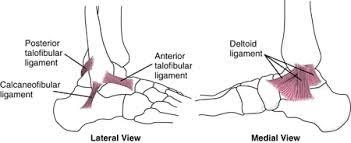Chronic Ankle Instability
What is Chronic Ankle Instability?
Ankle sprains are one of the most common injuries, particularly in athletics- occurring in at least 20% of athletes. Acute ankle sprains are typically treated conservatively with RICE (rest, ice, compression, and elevation) with a quick return to activity- usually within a few weeks. However, for many, there are lingering deficits that may go unnoticed at first and can lead to chronic ankle instability. Up to 33% of patients continue to report difficulties 1 year after an ankle sprain. Commonly reported difficulties to include pain, weakness in the foot, and ankle muscles, poor balance, poor neuromuscular control (How our brain and muscles coordinate movements), and poor proprioception (how our brain knows where our body is in space).
Chronic ankle instability can be functional, mechanical, or a combination of the two. Functional instability is typically based on reported symptoms and results from the deficits listed above. Mechanical instability is a direct result of increased laxity (i.e. looseness) of the supporting ligaments of the ankle, which can occur after injury. Chronic ankle instability can lead to recurrent ankle sprains and may result in further injury to ankle joint and surrounding bones, muscles, and ligaments.

- Bones: The ankle joint is formed by the tibia, fibula, and talus. These 3 bones articulate (move) in a complex manner that allows your foot and ankle to adapt to the changing demands as you walk. The talus sits right on top of the calcaneus (Heel bone), and right behind the navicular; Though the calcaneus and navicular are not inherently part of the ankle joint, but they are closely connected. The ankle can move dorsiflexion (up), plantarflexion (down), inversion (Foot comes in), and eversion (foot goes out).
- Ligaments: There are many ligaments that attach these bones together
- The inner part of your ankle is supported by the strong deltoid ligament complex that attaches the tibia to the navicular, the calcaneus, and the talus. It keeps the ankle stable during eversion of the foot and prevents subluxation of the ankle joint.
- The outer part of your ankle is supported by 3 small ligaments that are attached to the fibula and the talus, and calcaneus: anterior talofibular ligament, calcaneofibular ligament, & posterior talofibular ligament. These function to stabilize the ankle and guide its motion. They are resistant to inversion and internal rotation of the ankle. However, these are thin ligaments and are frequently injured with ankle injuries with the anterior talofibular ligament being the most commonly injured ligament.
- Muscles

How is Ankle Instability Diagnosed?
Ankle instability will be diagnosed based on a combination of the patient’s history and reported symptoms: Have you had ankle sprain(s) in the past? What is your normal level of activity and has that changed due to your symptoms? Do you feel unstable on your ankle or feel that it rolls a lot or gives out
The physical exam will focus on identifying any functional or mechanical deficits in the affected ankle. Typical tests include strength, range of motion, ligament testing, balance testing, assessing foot and ankle mechanics, and assessing for any areas of tenderness or swelling in the ankle. X-rays may be performed to rule out possible fractures or bony causes to your pain. MRI can also be a tool to diagnose ankle instability to identify swelling and other soft tissue injuries.
How can Physical Therapy Help Chronic Ankle Instability?
Physical therapy (PT) can help you gain back the strength and stability that your ankle is lacking after an acute ankle sprain or rebuild your confidence if you are suffering from chronic ankle instability. PT can help you identify the risk factors and work on improving the areas that are holding you back. Though every treatment is individual, typical areas that are addressed when treating ankle instability are: ankle strength, intrinsic foot strength, balance and proprioception training, and activity-specific exercises. At Kinetic, we work 1-on-1 with you to create a tailored program to fit your needs. Whether your goal is to get back out on the soccer field or just chasing after the grandkids, we work hard to help you get back on track.




